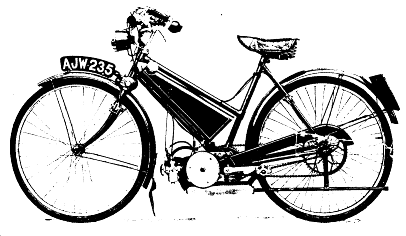 Go
to the Archive index
Go
to the Archive indexThe Jones autocycle was not really a marque in its own right, being a one-off prototype whose design was offered to several companies. It can be seen as the missing link between the early Cyc-Autos and the later Villiers-powered machines.
George Jones produced his machine in 1936, working in conjunction with Villiers. It was a machine of bicycle proportions, designed as a power-assisted cycle with pedalling in mind. The sprung front fork pivoted at the fork crown and was controlled by a leaf spring. Resilion Cantilevers, both front and rear, provided braking. The brake levers were conventional whilst a single inverted lever was used for the clutch. At first glance, the engine appears to be very similar to the production Junior, but closer inspection reveals that the cycle frame has no bottom bracket and that the pedal shaft is part on the engine, concentric with the clutch shaft. The feature of concentric power and pedal shafts was also used on the Cyc-Auto and was what enabled both designs to retain the proportions of a bicycle.

The Jones prototype autocycle
Raynal adopted the Jones design when it produced its first autocycle but the idea of concentric shafts was dropped. This redesign, whilst making the engine cheaper to produce, also destroyed the proportions on the machine. The wheelbase had to be lengthened to accommodate the extra shaft and this also meant moving the pedal back from the ideal pedalling position. George Jones did not approve of these changes to his design but, in practice, the design changes were vindicated. The Junior engine and its successors proved powerful and reliable enough to ensure that pedalling was rarely required.
The next article in this series will describe the Malvern Star autocycle.
First published - February 1999